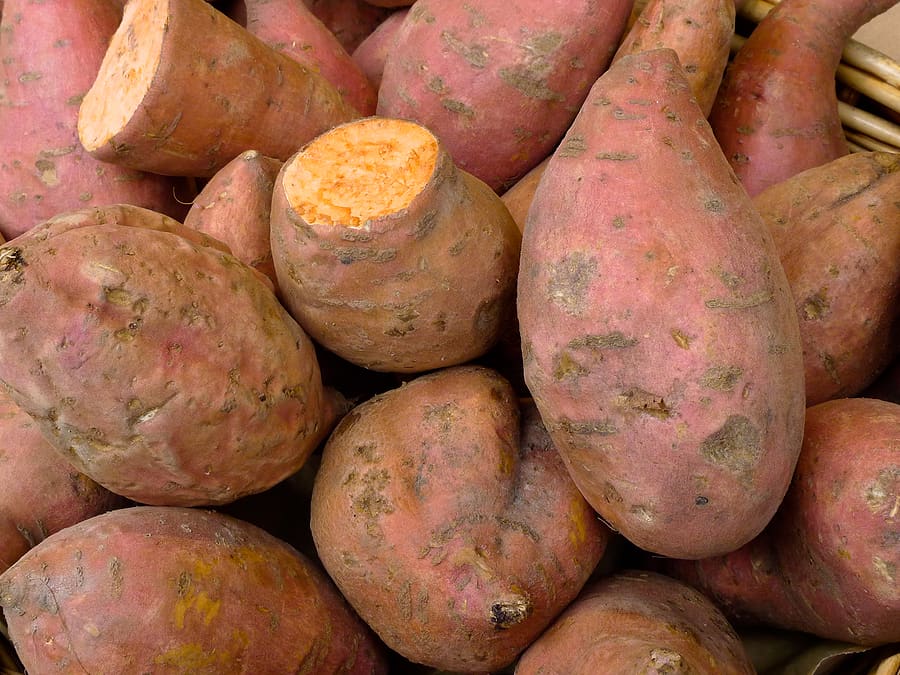Sweet potatoes are tender, warm-season perennial plants grown as annuals.
Sweet potatoes are commonly grown from rooted sprouts called slips. -purchased at the garden center or from a seed catalog.
Sweet potatoes require warm, frost-free weather to grow. The time to put sweet potato slips in the garden is after the soil has warmed to at least 60°F, or even better 70°F–usually about 2 weeks after the last frost. If nighttime air temperatures are consistently warmer than 60°F, the time is right to grow sweet potatoes.
Related articles:
- Seven Ways to Cook and Serve Sweet Potatoes
- Sweet Potato Plant Starting Tips
- How to Harvest and Store Sweet Potatoes
- Sweet Potato Growing Problems Troubleshooting
- How to Plant and Grow Sweet Potatoes

Sweet potato quick-growing tips
- Sweet potatoes require a long, warm growing season, usually about 4 months of frost-free weather to reach harvest.
- Set sweet potato starts or slips in the garden after all danger of frost has passed, usually 4 weeks after the last average frost date in early summer.
- Sweet potatoes grow best where the air temperature remains very warm, from 75° to 95°F (24-35°C) throughout the growing season.
- Sweet potatoes are best started indoors as early as 12 weeks before they are placed in the garden.
- Sweet potatoes require from 100 to 150 days to reach harvest.
Where to plant sweet potatoes
Plant sweet potato slips in low mounds or ridges not more than 6 inches high. Set slips 4 inches deep and from 18 to 36 inches apart. Add aged compost to the planting hole and plant slips up to their bottom leaves. Prepare the soil ahead of time by turning it 10 to 12 inches deep; sweet potatoes like mounded soil because it warms quicker and loose soil because potato tubers can easily expand.
- Plant sweet potatoes in full sun.
- Grow sweet potatoes in loose, well-worked, well-drained loamy, or somewhat sandy soil with aged compost added.
- Prepare the planting bed by adding aged compost and aged manure or a commercial organic planting mix across the bed then turn the soil 12 inches (30cm) deep.
- Soil that is overly rich in nitrogen will produce more foliage than tubers.
- Remove all soil lumps, rocks, or other obstacles from the planting bed; if tubers hit an obstacle as they develop, they will grow deformed.
- Sweet potatoes prefer a soil pH of 5.0 to 6.5.
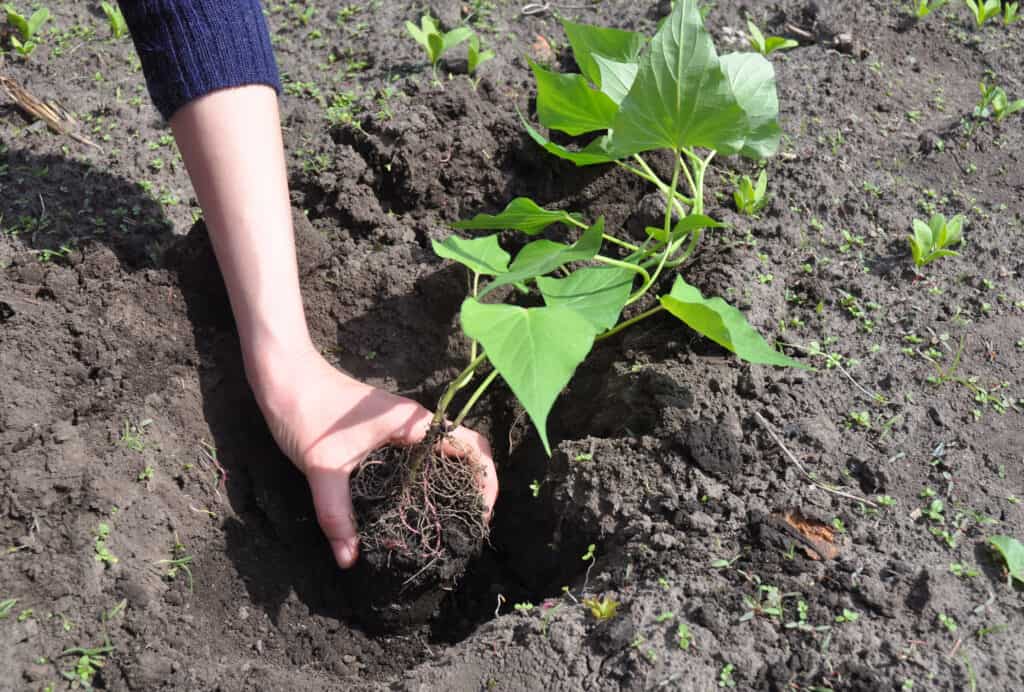
Sweet potato planting time
- Set sweet potato starts in the garden after all danger of frost is past in spring, usually about 4 weeks after the last frost.
- Sweet potatoes are extremely sensitive to frost and need a warm, moist growing season of as many as 150 days.
- Sweet potato slips can be started indoors as early as 12 weeks before they are transplanted into the garden.
- Well-rooted sweet potatoes require a soil-growing temperature of 60° to 85°F (16-29°C) and an air-growing temperature of 65° to 95°F (18-35°C).
- Sweet potatoes will thrive in air temperatures as high as 100°F (37°C).
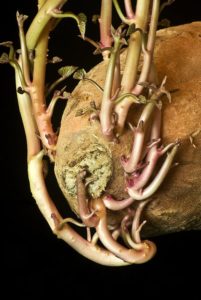
Starting sweet potato sprouts or slips
Grow sweet potatoes from rooted sprouts, called slips, taken from a mature tuber. Here are two ways to start sweet potato slips:
- Place the sweet potato in a jar of water that is half full with about one-third of the tuber submerged. Leave it in a warm (75°F/24°C)), sunny location where it will sprout. When sprouts are 6 inches (15cm) long, pull them off the tuber and set them in water or damp sand; they will root in a few days. Start this process about 12 weeks before you plan to set the slips in the garden.
- Place cut pieces of a tuber moist sand or light growing medium with a constant temperature of about 80°F (26°C). (Use a heating mat with a thermostat to keep the soil consistently warm.) Each piece must have one or more “eyes or sprouts. Set each piece 2 to 4 inches (5-10cm) deep in sand or light soil. Shoots will appear in about 3 weeks. When shoots appear, add another inch of sand or light soil. Do not let the growing medium dry out. When sprouts reach 3 to 4 inches (7-10cm) tall reduce the soil temperature to 70°F (21°C) and grow on for another 3 weeks. Seed tubers will be rooted in about 6 weeks and can then be planted in the garden.
You can start slips in one-gallon containers or in a hotbed. If you plant in a hotbed space slips 3 to 4 inches (7-10cm) apart.
One sweet potato tuber can yield as many as a dozen slips.
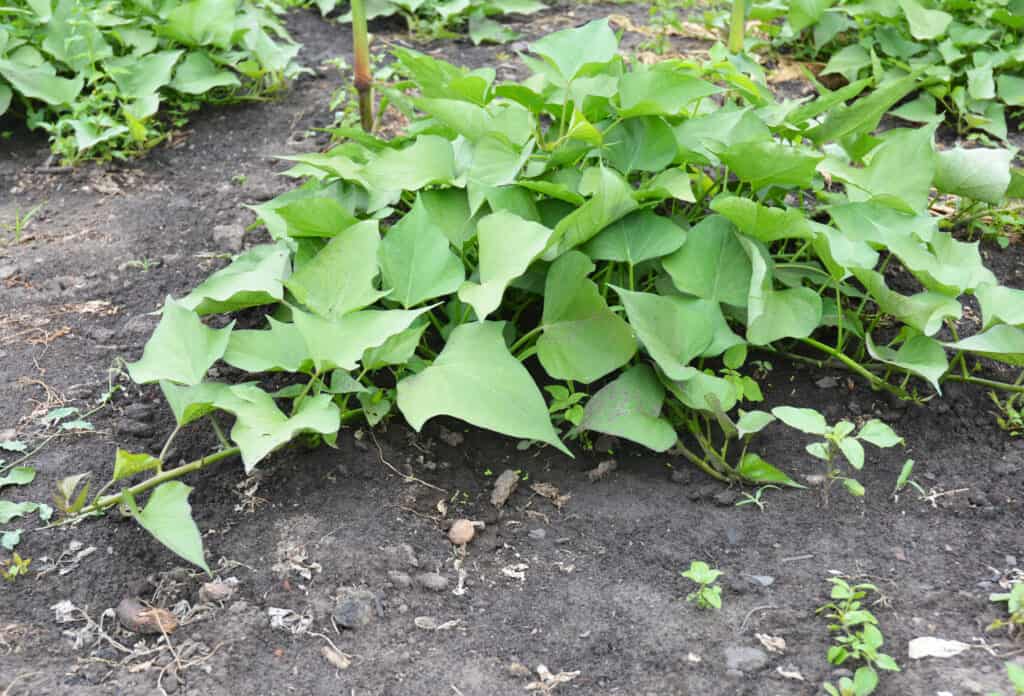
Planting sweet potatoes in the garden
- Set rooted slips in the garden on mounded rows 12 inches (30cm) wide and 8 inches (20cm) high; space rows 3 feet apart (.9m); plant slips at 12 to 18-inch (30-45cm) intervals.
- Plant slips so that the sprouts grow up toward the sky, not sideways. Be sure to cover all of the roots and about a ½ inch (12mm)of the stem.
- Protect tender sweet potato foliage from the direct hot sun for five days after planting. Set a floating row cover over the plants.
- Grow 5 sweet potato plants for each household member.
Companion plants for sweet potatoes
- Grow sweet potatoes with other root crops: beets, parsnips, and salsify.
Container-growing sweet potatoes
- Grow a single sweet potato plant in a box or tub that is at least 12 inches (30cm) deep and 15 inches (38cm) wide.
- Use a light, porous soil mix.
- Place a stake or trellis in the center to support the vine which grows up and outwards.
Watering sweet potatoes
- Sweet potatoes will tolerate dry soil once established but will produce best if kept evenly moist, an inch of water every week (1 inch equals 16 gallons/60.5 liters) until 3 to 4 weeks before harvest.
- Do not overwater sweet potatoes; tubers will rot in soil that is too wet.
Feeding sweet potatoes
For best results, give sweet potatoes a compost tea side dressing once a month, and keep them well-weeded (especially in the first 40 days) and well-watered. It’s true that sweet potatoes are drought resistant–they will survive dry weather that kills other vegetables, but for the very best yield water sweet potatoes just like other garden vegetables, about three gallons per vine per week.
- Add aged compost or commercial organic planting mix to planting beds before planting. Aged compost contains all the nutrients sweet potatoes need to get started.
- Feed newly planted slips with a B-1 starter solution or compost tea.
- Add a low nitrogen fertilizer (5-10-10) to the soil two weeks before planting.
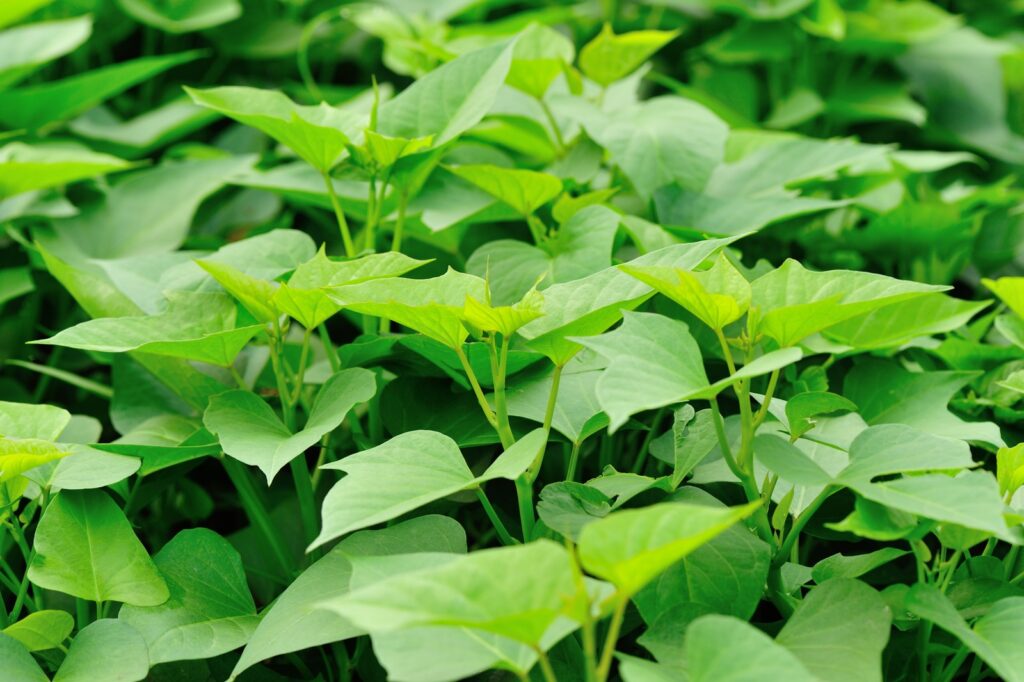
Sweet potato care
- Sweet potatoes are easily trained onto trellises, lattices, or wires strung between sturdy poles.
- Keep weeds away from young plants. Mulch around plants with loose straw or chopped, dried leaves to control weeds and slow soil moisture evaporation.
- Pull weeds by hand or cultivate shallowly to avoid disturbing roots. Eventually, the foliage of the maturing sweet potato plant will shade out new weeds.
- If wet weather hits your garden during the summer growing season, gently lift sweet potato vines after each good rain. Sweet potatoes will send down roots from their nodes if given the chance. New roots will result in many undersized potatoes. For bigger sweet potatoes, let sweet potatoes root only from their base. (When vines run down their hills, place a couple of sheets of newspaper between the plant and the soil so that new roots don’t set.)
- Mulching sweet potatoes with straw is a good idea only in the warmest regions. Mulching will help keep the soil cool, and that is counter-productive for sweet potatoes growing in cooler regions. The warmer the soil the faster the sweet potato will grow and reach harvest.
Sweet potato pests
- Insects are not likely to attack sweet potatoes in northern regions. In southern regions, sweet potato weevils and wireworms are common pests.
- Weevil larvae chew holes in tubers and adults chew holes in leaves. Control adult weevils by knocking them from plants and crushing them or spray with pyrethrins.
- Plant disease-resistant varieties.
- Where heavy infestations occur remove all plants and do not re-plant in that area for three years.
Sweet potato diseases
- Sweet potatoes are susceptible to root rot and fungal diseases including a fungus disease called scurf.
- Plant disease-resistant varieties and keep the garden clean of debris and weeds where pests and diseases can harbor.
- Remove and destroy infected plants immediately before the disease can spread to healthy plants.
- Scurf is a fungal disease that grows on the skin of sweet potatoes. The skin develops shallow purple or grayish-brown lesions. Prevention is the best control. Plant certified disease-free slips. Rotate sweet potatoes out of an infected bed for three years.
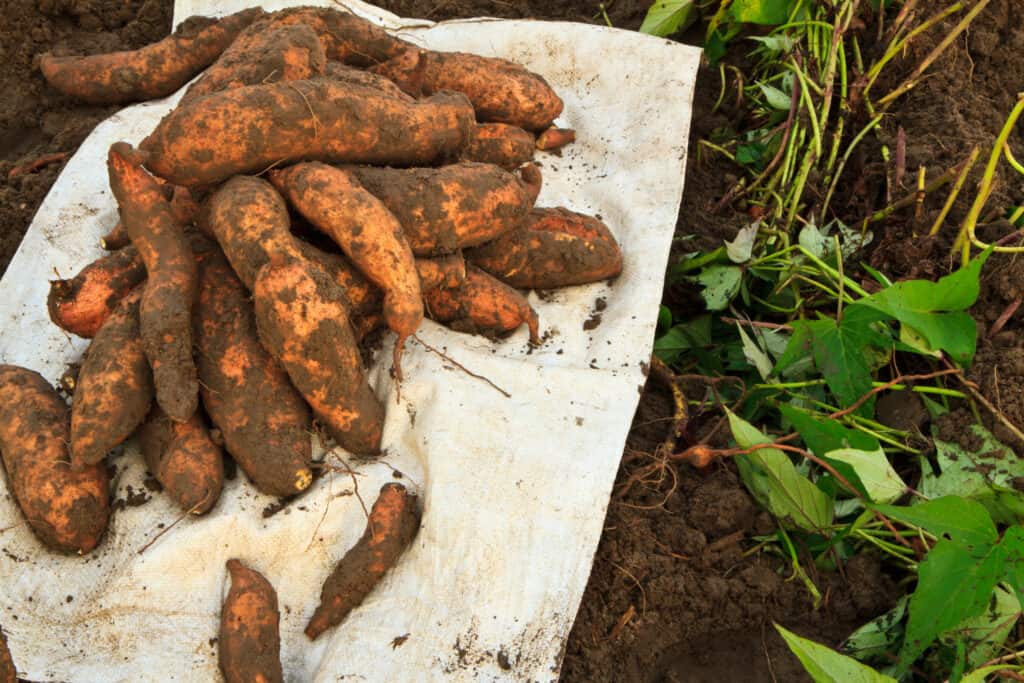
Harvesting sweet potatoes
Harvest sweet potatoes as soon as they are big enough to eat. If you want to let them get to full size, leave them in the ground until the frost kills the vine–the first frost will sweeten the roots. But once frost hits, get your sweet potatoes harvested in the next few days; if you leave them too long they will begin to spoil.
- Sweet potatoes require from 100 to 150 days to reach harvest.
- Lift sweet potato tubers when they have reached full size, commonly when leaves and vines have begun to yellow and wither.
- Carefully dig plants using a garden fork starting about 15 to 18 inches (38-45cm) from the center of the vine and working inwards lifting. Tubers will be 6 inches (15cm) or so deep in the soil. Be careful not to cut or bruise the tubers which are thin-skinned.
- Complete the harvest before the first frost in fall; tubers are damaged by freezing or cold weather.
Storing and preserving sweet potatoes
- Cure (dry and harden) sweet potato tubers for 10 to 15 days after harvest. Set them in a warm spot (about 80°F) out of direct sunlight. Curing will help heal nicks and cuts and harden the skin. Curing will also improve the sweetness of the tuber.
- Sweet potatoes will store at 55° to 60°F (13-16°C) in a dry, cool, well-ventilated place for 4 to 6 months.
- Store sweet potatoes unwashed. Wrap the tubers in a newspaper when you store them; don’t let the tubers touch or they may rot.
- If you plan to put sweet potatoes into long storage, cure them first. Put them in the sun for a day or two allowing the soil on the tuber to dry. Then brush them off and place them in a hot (80 to 90°F), humid spot for 10 days. After, wrap each tuber in a newspaper (so that they won’t touch) and store them where they will keep at 55 to 65°F for 6 months or more.
- Do not refrigerate or store sweet potatoes at temperatures below 50°F (10°C).
- Sweet potatoes can be frozen, canned, or dried.
Sweet potato varieties to grow
Sweet potato tubers are described as “dry” and “moist” noting the texture of the tuber when eaten. “Moist” sweet potatoes are often called yams; however, the true yam is actually a different species found in tropical regions.
- Varieties: ‘Beauregard’ (moist-fleshed, 100 days); ‘Boniato’ (dry-fleshed, 120 days); ‘Centennial’ (moist-fleshed, 110 days); ‘Georgia Jet’ (moist-fleshed, 100 days); ‘Goldrush’ (140 days); ‘Jasper’ (150 days); ‘Jewel’ (moist-fleshed, 100 days); ‘Nancy Hall’ (moist-fleshed, 110 days); ‘Porto Rico’ (moist-fleshed, 110 days); ‘Southern Delite’ (moist-fleshed, 100 days); ‘Vardaman’ (moist-fleshed, 110 days); ‘White Yam’ (dry-fleshed, 120 days); ‘Yellow Jersey’ (dry-fleshed, 120 days).
Short-season sweet potato varieties
- Beauregard (90-100 days): orange flesh, extremely high yields.
- Bush Porto Rico (110 days): sweet, red-orange flesh, baking favorite, high yields, compact for small gardens.
- Centennial (90-100 days): sweet, moist, mostly yellow flesh, good keeper, vining habit, widely adapted.
- Georgia Jet (90 days): moist, excellent flavor, deep-orange flesh, vining habit, good in the north, table-size tubers in 75 days.
- Jewell (100 days): moist, sweet flesh, deep-orange flesh, soft texture-quick baker, keeps well, vining habit.
- Vardaman (110 days): rich flavor, deep-orange flesh, best eating for a short-vine variety; bush habit.
About sweet potatoes
- The sweet potato is a tender vining or semi-erect perennial plant grown for its swollen fleshy tuber, similar to an elongated potato.
- Tubers grow underground from the vine’s central shoot.
- Tubers vary from creamy-yellow to light brown to deep red-orange in color and from 4 or 5 inches (10-12cm) to 8 inches (20cm) or more in length.
- The flesh of the tuber is yellow or gold.
- The flower of the sweet potato is pink to purple colored.
- Botanical name: Ipomoea batatas
- Origin: Tropical America and the Caribbean
More tips: How to Harvest and Store Sweet Potatoes
Garden Planning Books at Amazon:
- Vegetable Garden Grower’s Guide
- Tomato Grower’s Answer Book
- Vegetable Garden Almanac & Planner
- Kitchen Garden Grower’s Guide Vegetable Encyclopedia
More how to grow articles:
Learn how to plant, grow, and harvest your favorite vegetables. Click below for all you need to know.
- Artichoke
- Arugula
- Asparagus
- Beans, Snap
- Beets
- Broad Beans
- Broccoli
- Brussels Sprouts
- Cabbage
- Cantaloupe — Melons
- Cardoon
- Carrots
- Cauliflower
- Celeriac
- Celery
- Chard
- Chayote Squash
- Chickpeas
- Chicory
- Chinese Cabbage
- Collards
- Corn Salad
- Corn, Sweet
- Cresses
- Cucumbers
- Eggplant
- Endive and Escarole
- Fava Beans
- Florence Fennel
- Garbanzo Beans
- Garlic
- Horseradish
- Jerusalem Artichoke
- Kale
- Kohlrabi
- Leeks
- Lettuce
- Lima Beans
- Melons
- Mizuna
- Mustard Greens
- New Zealand Spinach
- Okra
- Onions
- Parsnips
- Peanuts
- Peas
- Peppers
- Potatoes
- Pumpkins
- Radicchio
- Radishes
- Rhubarb
- Rutabaga
- Salsify
- Shallots
- Sorrel
- Southern Peas
- Soybeans
- Spinach
- Squash, Summer
- Squash, Winter
- Sunchokes
- Sweet Potato
- Swiss Chard
- Taro
- Tomatillo
- Tomatoes
- Turnips
- Watermelon
- Zucchini

